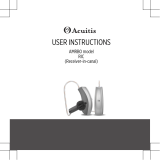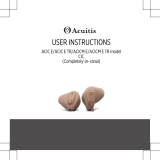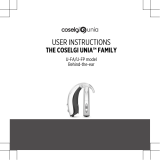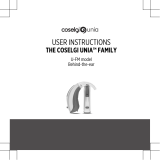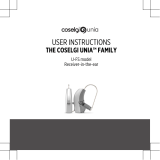
USER INSTRUCTIONS
THE WIDEX MOMENT™ FAMILY
MBB2 model
BTE
(Behind-the-ear)

YOUR HEARING AID
(To be filled out by the hearing care professional)
This is a list of possible programs for your hearing aid. For further
information on the use of these programs, see "Programs" under
"Customization".
Your hearing aid series:
PROGRAMS AUDIBILITY EXTENDER
Universal
PureSound
Quiet
Comfort
Transport
Urban
Impact
Party
Social
Music
2

SPECIAL PROGRAMS AUDIBILITY EXTENDER
Zen
Phone
SMARTTOGGLE PROGRAMS AUDIBILITY EXTENDER
Zen+
The program names in the table are the default names. If you have chosen
to use some of the other names available, write the new names in the table.
That way you will always know which programs you have in your hearing
aids.
Read the instructions
Read this booklet and the booklet "Ear-sets for Widex hearing aids"
carefully before you start using your hearing aid.
Sound streaming and wireless control
This hearing aid allows direct wireless control and sound streaming from
smartphones and other devices. For more help and information contact your
hearing care professional or visit: https://global.widex.com/MOMENT.
This hearing aid works wirelessly with the TONELINK app. We take no
responsibility if the hearing aid is used with any third part app or if the
TONELINK app is used with any unsupported devices.
3

CONTENTS
IMPORTANT SAFETY INFORMATION..........................................................6
YOUR HEARING AID...................................................................................9
Welcome...........................................................................................................9
Your hearing aid at a glance.......................................................................9
CONDITIONS FOR USE..............................................................................10
Indications for use..........................................................................................10
Intended use...................................................................................................10
Operating conditions...................................................................................... 11
Storage and transport conditions................................................................. 11
DAILY USE................................................................................................ 13
Turning the hearing aid on and off...............................................................13
Putting on and removing the hearing aid...................................................13
How to tell right from left..............................................................................14
THE BATTERY........................................................................................... 15
Low battery indication...............................................................................15
Changing the battery................................................................................. 15
CUSTOMIZATION...................................................................................... 18
Programs.........................................................................................................18
The Zen program.......................................................................................20
Sound signals.................................................................................................20
4

Lost partner ................................................................................................ 21
Program and sound adjustment...................................................................21
CLEANING................................................................................................23
Tools................................................................................................................23
How to clean your hearing aid.....................................................................23
ACCESSORIES.......................................................................................... 25
TROUBLESHOOTING................................................................................ 26
REGULATORY INFORMATION...................................................................28
FCC and ISED statements.............................................................................28
EU directives.................................................................................................. 30
Directive 2014/53/EU................................................................................30
Information regarding disposal.................................................................31
SYMBOLS................................................................................................. 32
5

IMPORTANT SAFETY INFORMATION
Read these pages carefully before you begin using your hearing aid.
Hearing aids and batteries can be dangerous if swallowed or used
improperly. Swallowing or improper use can result in severe injury or
even fatalities. In case of ingestion, contact your local emergency
number or hospital immediately.
Take your hearing aids out when you are not using them. This will help to
ventilate the ear canal and prevent ear infections.
Contact your doctor or hearing care professional immediately if you
suspect you may have an ear infection or an allergic reaction.
Contact your hearing care professional if the hearing aid doesn't feel
comfortable, or if it doesn't fit properly, causing irritation, redness or the
like.
Remove your hearing aids before showering, swimming or using a hair
dryer.
Do not wear your hearing aids when applying perfume, spray, gels, lotion
or cream.
Do not dry your hearing aid in a microwave oven - this will ruin it.
Never use other people’s hearing aids and never allow others to use
yours, as this could damage your hearing.
Never use your hearing aids in environments where there may be
explosive gases, such as in mines, etc.
6

Keep hearing aids, their parts, accessories and batteries away from
children and mentally disabled people.
Never try to open or repair the hearing aid yourself. Contact your hearing
care professional if you need to have your hearing aid repaired.
Your hearing aids contain radio communication technology. Always
observe the environment in which you are using them. If any restrictions
apply, you must take precautions to comply with these.
Your device has been designed to comply with international
electromagnetic compatibility standards. However, it cannot be excluded
that it may cause interference with other electrical equipment. If you
experience interference, keep a distance to other electrical equipment.
Your hearing aid is very powerful and it can play sounds that exceed a
level of 132 dB. There may therefore be a risk of damaging your
remaining hearing.
Do not expose your hearing aids to extreme temperatures or high
humidity, and dry them quickly if they get wet, or if you perspire heavily.
Please note that streaming sound to your hearing aids at a high volume
can prevent you from hearing other important sounds such as alarms and
traffic noise. In such situations make sure to keep the volume of the
streamed sound at a suitable level.
Your hearing aids should be stored and transported within the temperature
and humidity ranges of -20°C to +55°C (-4°F to 131°F) and 10%-95% rH.
Your hearing aids are designed to operate within the temperature, humidity
and atmospheric pressure ranges of 0°C (32°F) to 50°C (122°F), 10%-95% rH
and 750 to 1060 mBar.
7

You can find technical data sheets and additional information on your
hearing aids on https://global.widex.com.
8

YOUR HEARING AID
Welcome
Congratulations on your new hearing aid.
Use your hearing aid regularly, even if it takes some time getting used to it.
Infrequent users don’t usually get the full benefit of a hearing aid.
Your hearing aid and its accessories may not look exactly as illustrated in
this booklet. We also reserve the right to make any changes we consider
necessary.
Your hearing aid at a glance
1
2
3
4
5
1. Ear-set
2. Microphone openings
3. Push button
4. Battery lid with nail grip
5. Left/right identification. Blue
indicates your left hearing aid, while
red is for your right hearing aid.
9

CONDITIONS FOR USE
Indications for use
The hearing aids are indicated for individuals older than 36 months with a
range of hearing loss from minimal (0 dB HL) to severe (95 dB HL) and all
hearing loss configurations.
They are to be programmed by licensed hearing care professionals
(audiologists, hearing aid specialists, otolaryngologists) who are trained in
hearing (re)habilitation.
Intended use
The hearing aids are intended as air conduction amplification devices to be
used in everyday listening environments. The hearing aids may be equipped
with the Zen program, intended to provide a relaxing sound background
(i.e. music/noise source) for adults who desire to listen to such a
background in the quiet.
10

Operating conditions
Your hearing aid has been designed to operate in everyday situations, and it
works in environmental conditions that are comfortable for you. You can
wear your hearing aid during flights, but you should remove it before
showering or swimming.
Specific operating conditions for your hearing aid:
Minimum Maximum
Temperature 0°C (32°F) 50°C (122°F)
Humidity 10% rH 95% rH
Atmospheric pressure 750 mbar 1060 mbar
Storage and transport conditions
Your hearing aid is sensitive to extreme conditions such as high
temperatures. It should not be stored or transported in direct sunlight, but
only within the following conditions.
Specific storage and transport conditions:
Minimum Maximum
Temperature -20°C (-4°F) 55°C (131°F)
11

Minimum Maximum
Humidity 10% rH 95% rH
You can find technical data sheets and additional information on your
hearing aids on https://global.widex.com.
12

DAILY USE
Turning the hearing aid on and off
To turn the hearing aid on, close the battery door. The
hearing aid will play a sound signal to indicate that it is
on, unless your hearing care professional has
deactivated this function.
To turn off the hearing aid, pull the battery door
downwards.
NOTE
Don't forget to turn off the hearing aid when it is not in use.
Putting on and removing the hearing aid
Putting on the hearing aid
1
2
1. Insert the ear-set in the ear while holding the lower
part of the tube/earwire. Pulling the outer ear upwards
and backwards at the same time can be helpful.
2. Then place the hearing aid behind the ear. The hearing
aid should rest comfortably on the ear, close to your
head.
13

Your hearing aid can be fitted using different types of ear-sets. See the
separate ear-set manual for more information about your ear-set.
Removing the hearing aid
Start by removing the hearing aid from behind the
ear.
Then take the ear-set carefully out of the ear canal
while you hold the lower part of the tube/earwire.
How to tell right from left
The hearing aid for your right ear has a red mark. The hearing aid for your
left ear has a blue mark.
14

THE BATTERY
Use a type 312 zinc-air battery for your hearing aid.
Always use a fresh, new battery that is precisely the kind recommended by
your hearing care professional.
NOTE
Check that the battery is completely clean and free of any residue before
inserting it in the hearing aid. Otherwise your hearing aid may not function as
expected.
Never attempt to recharge a zinc-air hearing aid battery, as it could
explode.
Never leave a flat battery in the hearing aids while storing them. It could
leak and ruin your hearing aid.
Dispose of used batteries as indicated on the packaging and take note of
the expiry date.
Low battery indication
When the battery is flat, a sound signal will play. If the battery drains
suddenly there may however be no warning. We recommend carrying a
spare battery with you wherever you go.
Changing the battery
To change the battery, do as follows:
15

Take the adhesive tab off the new battery and make
sure there is no sticky substance left on it. Let it
"breathe" for 60 seconds.
Use the nail grip to gently swing the battery door
open and remove the old battery.
Now place the new battery in the drawer as shown.
Close the drawer. If it doesn't close easily, the
battery is not placed correctly.
If you are not using the hearing aid for a few days,
remove the battery.
NOTE
Avoid dropping your hearing aid - hold the hearing aid above a soft surface
while changing the battery.
WARNING - KEEP BATTERIES OUT OF REACH OF CHILDREN
●For some types of button batteries, swallowing may lead to serious
injury in as little as two hours or death, due to chemical burns and the
potential perforation of the oesophagus.
●If you suspect your child has swallowed or inserted a button battery, call
the 24-hour Poisons Information Centre immediately on 13 11 26 for fast,
expert advice.
16

●Examine devices and make sure the battery compartment is correctly
secured, e.g. that the screw or other mechanical fastener is tightened.
Do not use if compartment is not secure.
●Dispose of used button batteries immediately and safely. Used/
discharged batteries can still be dangerous.
●Tell others about the risk associated with button batteries and how to
keep their children safe.
17

CUSTOMIZATION
Programs
This is an overview of programs that you can select from. Ask your hearing
care professional for guidance.
PROGRAMS USE
Universal Automatic program with focus on optimum
sound in all situations
PureSound Automatic program with focus on natural and
pleasant sound in all situations
Quiet Special program for listening in quiet
environments
Comfort Special program for listening in noisy
environments
Transport For listening in situations with noise from cars,
trains, etc.
Impact Use this program if you prefer a clear and sharp
sound
Urban For listening in situations with changing sound
levels (in supermarkets, noisy workplaces or
similar)
18

PROGRAMS USE
Party For listening in situations with many people
talking at the same time
Social Use this program if you are in small social
gatherings, such as family dinners
Music For listening to music
SPECIAL PROGRAMS USE
Zen Plays tones or noise for a relaxing sound
background
Phone This program is designed for listening to phone
conversations
SMARTTOGGLE
PROGRAMS USE
Zen+ This program is similar to Zen but allows you to
listen to different types of tones or noise
The names in the list of programs are the default names. Your hearing care
professional can also select an alternative program name from a preselected
list. Then it is even easier for you to select the right program in each
listening situation.
19

Depending on your hearing loss, your hearing care professional can activate
the Audibility Extender feature. Ask your hearing care professional if you
could benefit from this.
If your needs and preferences change over time, your hearing care
professional can easily change your program selection.
The Zen program
Your hearing aid may be provided with a unique optional listening program
called Zen. It makes musical tones (and sometimes a rushing noise) in the
background.
If you perceive a decrease in loudness or tolerance of sounds, speech not
to be as clear, or worsening tinnitus, contact your hearing care
professional.
Use of the Zen program may interfere with hearing everyday sounds,
including speech. It should not be used when it is important to be able to
hear such sounds. Switch the hearing aid to a non-Zen program in these
situations.
NOTE
You can also use your app for changing programs and adjusting the sound in
your hearing aids.
Sound signals
Your hearing aid plays sounds to inform you that certain features have been
activated or that you have changed program. These sounds can be spoken
messages or tones.
20
Page is loading ...
Page is loading ...
Page is loading ...
Page is loading ...
Page is loading ...
Page is loading ...
Page is loading ...
Page is loading ...
Page is loading ...
Page is loading ...
Page is loading ...
Page is loading ...
Page is loading ...
Page is loading ...
Page is loading ...
Page is loading ...
/
